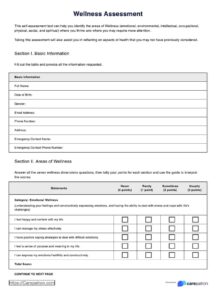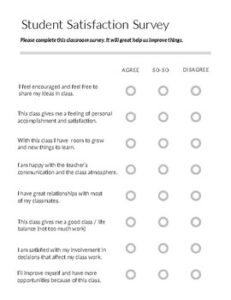Supporting the mental and emotional health of those who dedicate their lives to educating our children is more important than ever. Teachers and school staff work incredibly hard, often facing significant pressures, and their wellbeing directly impacts the learning environment and student success. When staff feel valued, supported, and heard, it creates a more positive and productive atmosphere for everyone in the school community.
Understanding the current state of wellbeing within your team is the first crucial step towards creating a truly supportive school culture. This is where a well-designed survey comes into play, offering a confidential and structured way to gather honest feedback. By using a thoughtfully constructed school staff wellbeing survey template, you can identify areas of strength and, more importantly, pinpoint where improvements are needed to better support your most valuable asset: your people.
Why a Wellbeing Survey is Crucial for Your School Community
Taking the pulse of your school staff’s wellbeing isn’t just a nice-to-have; it’s a fundamental component of effective leadership and a thriving educational environment. When staff wellbeing is neglected, schools often see increased rates of burnout, stress-related absences, and a higher turnover of experienced educators. These factors not only disrupt learning continuity but also place additional strain on remaining staff, creating a detrimental cycle. A systematic approach, like deploying a dedicated survey, demonstrates to your team that their health and happiness are genuinely valued.
Beyond simply identifying problems, a comprehensive survey provides invaluable data that can inform strategic decisions. It moves beyond anecdotal evidence and gut feelings, offering concrete insights into common challenges across different departments or roles. This data can then be used to tailor interventions, allocate resources effectively, and develop targeted support programs that truly address the specific needs of your staff. For instance, if the survey highlights excessive workload as a recurring theme, it might prompt a review of administrative tasks or curriculum demands.
Furthermore, implementing a wellbeing survey fosters a culture of open communication and trust. When staff feel safe to express their concerns anonymously, they are more likely to provide honest feedback, which is essential for meaningful change. It signals that leadership is proactive and committed to creating a healthy workplace, not just reactive to crises. This proactive stance can significantly boost morale and loyalty, as staff see their voices are not only heard but acted upon.
Ultimately, investing in staff wellbeing translates directly into benefits for students. Happy, healthy, and supported staff are more engaged, more resilient, and better equipped to provide high-quality education and pastoral care. They can model positive coping strategies and create a nurturing environment where both students and adults can flourish. Without understanding their needs, it’s difficult to implement effective support systems.
Key Areas to Cover in Your Survey
When developing a school staff wellbeing survey template, ensure it covers a range of interconnected areas that impact daily work life and overall health. Here are some critical dimensions to include:
- Workload and demands: Questions about manageable tasks, time pressures, and administrative burdens.
- Professional development and growth opportunities: Understanding if staff feel supported in enhancing their skills and career progression.
- School culture and relationships: Exploring aspects like collegiality, communication, and feelings of belonging.
- Leadership and management support: Assessing whether staff feel adequately supported by their direct managers and school leadership.
- Work-life balance: Gauging the ability of staff to maintain a healthy boundary between their professional and personal lives.
- Access to wellbeing resources: Inquiring about awareness and accessibility of mental health support, counseling, or stress management programs.
- Recognition and appreciation: Understanding if staff feel valued for their contributions.
Designing and Implementing Your Staff Wellbeing Survey Effectively
Crafting the perfect school staff wellbeing survey template is just the beginning; its true value comes from how it’s designed and, more importantly, how the information gathered is put into action. To ensure you get insightful and actionable data, your survey needs to be clear, concise, and genuinely confidential. Staff need to feel completely secure in providing honest feedback without fear of reprisal, so emphasizing anonymity is paramount. Consider using a neutral third-party platform or clearly communicating the data handling process.
When it comes to distribution, think about accessibility for all staff members. Online survey tools are generally efficient and make data analysis easier, but consider if any staff might prefer or need a paper-based option. Communicate the purpose of the survey clearly before sending it out: explain why you are doing it, what you hope to achieve, and how long it might take to complete. Setting a reasonable deadline and sending polite reminders can also help improve response rates, ensuring you get a comprehensive picture from your team.
Once the responses are in, the real work begins: data analysis. Look for patterns, recurring themes, and significant outliers. Categorize feedback to identify specific areas of concern, such as workload, communication, or professional development. Don’t shy away from uncomfortable truths; this feedback is a gift that offers a pathway to improvement. Consider involving a small, trusted group of staff in the initial analysis to gain diverse perspectives and build buy-in for subsequent actions.
The final, and arguably most critical, step is to act on the insights gained. It’s not enough to simply collect data; staff need to see tangible outcomes from their participation. Share a summary of the findings with the whole staff, outlining key themes and, crucially, detailing the specific actions the school plans to take in response. This could involve creating new policies, offering additional support, or adjusting practices. Remember, a survey is not a one-time event but part of an ongoing commitment to fostering a positive and supportive work environment.
Investing in the wellbeing of your school staff is an investment in the future success and stability of your entire institution. By regularly assessing and responding to the needs of your educators and support teams, you cultivate a resilient, positive, and high-performing environment. This proactive approach not only mitigates potential challenges but also champions a culture where every member feels valued, heard, and empowered to thrive.
Ultimately, a school that prioritizes the health and happiness of its staff sends a powerful message that cares for its most vital resource. Such an environment fosters greater dedication, reduces turnover, and ensures that the passion for education continues to burn brightly. It helps build a community where everyone can contribute their best, leading to better outcomes for students and a more harmonious workplace for all.


